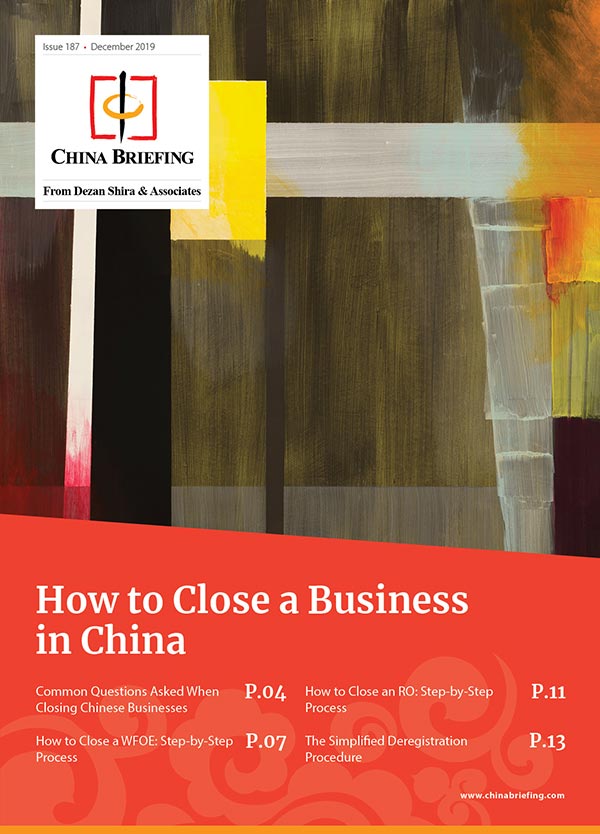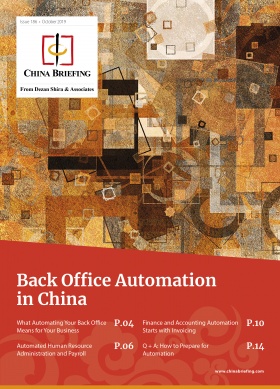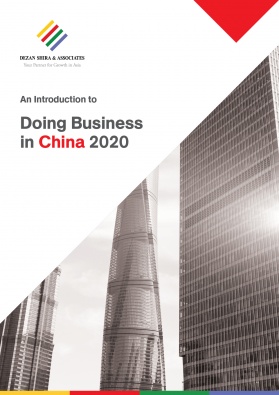China’s Global Trade Outlook in 2020: The Risks and Rewards
Unpredictability with the US, Sustainability in Europe, Eurasia, Asia, and the Belt and Road Initiative, and Development in Africa and South America
There are plenty of opportunities for foreign investors looking at China’s trade corridors in 2020. But where are they?
Op/Ed by Chris Devonshire-Ellis
Up until the last couple of years, predicting the investment trends in China was relatively straightforward – growth at about eight percent, low interest rates and good infrastructure, and a relatively buoyant global consumer demand all made China a global play for foreign investors to get on board and take advantage. In some ways, what has happened since then has been foisted upon China, rather than China being the instigator. Trade wars. Global political squabbles. Growing protectionism. Sanctions. Falling global demand.
The US-China trade war has dominated the minds and comments of many and has certainly impacted upon American companies sourcing product from China for resale in the US. Naturally, this has diminished US-China trade as a result. But like a lot of contemporary media, the needle got stuck on the same subject: US-China trade war opinions, day in, day out. The only other media coverage more repetitive, dull, often inaccurate and politicized during 2019 was Brexit.
2019 has been a dreadful year for insightful, adventurous, and illuminating China trade news and intelligence. That has painted an inaccurate image as in fact it hasn’t all been that bad.
Instead, in many ways, 2019 was a banner year for China. The US-China trade war (how many times have you read that term the past 12 months, dear reader?) dominated, but was far from being the only game in town even if that was all many journalists appeared able to write about. But for every negative action, there must be a positive reaction. That is the place businesses looking ahead to 2020 should be inhabiting. But where are the potential positive trends?
US-China bilateral trade
US trade has become so politicized these days that it is being directly linked as a tool with which to determine the outcome of US election campaigns. If candidates feel beating up on China is a good bet to gain votes, then US presidents and American politicians seem prepared to do so to curry favor with their voter base. This makes it hard to predict what will happen in US-China relations in 2020, as the US will also immediately start gearing up for the frankly tedious months of electioneering that will take place from now until November, when the next president will be elected.
Yet, despite all this, and a lack of media interest in the subject, there is hope for a US-China bilateral investment treaty, and negotiations are currently being held on this issue. Such a deal would both provide better protection for US companies in China and open up more China market access. We commented on this in the article Prospects for a US-China Bilateral Investment Treaty last week. If this happens – and we’ve outlined several reasons why it could – it’ll be good news for US business and trade with China.
However, due to the trade war – which is still in the process of being rolled back and could, given President Trump’s ability to make knee-jerk reactions also return, I foresee a bumpy ride ahead. US corporations sourcing Chinese product for US consumption have already been burned, and they should continue their relocation into other markets and especially, ASEAN. Our new issue of China Briefing Magazine is out now, is a complimentary download, and is titled Relocating Your Business from China to ASEAN. US companies looking at supplying their domestic markets should be acting on that advice. But it’s not all difficult news.
As concerns China’s domestic market, the trend appears to be upwards after an awkward year; a useful McKinsey China 2020 Consumer Report here exhibits strong growth trends in many sectors, while the China Consumer Confidence Index recently hit a ten-year high. Investing in China for the Chinese consumer market is still a major attraction for foreign investment, and China remains a strong market to invest in and make a sizable return for businesses with the right product. China’s new Foreign Investment Law has come into effect from January 1 this year and it opens up many new sectors for foreign investment, including taking part in Chinese domestic procurement contracts. Our complimentary China Briefing Magazine The New Foreign Investment Law in China explains this in some detail. For US-China trade, the answer to the question as to how good 2020 will be is – depends on which sector you are involved with. Fulfilling Chinese demand is still good business.
China and the European Union
It’ll be more of the same for China and the EU – as a new leadership in Brussels starts to find its way, it will be preoccupied with Brexit. No free trade deal will emerge, and the EU will continue to be suspicious of Chinese built infrastructure close to its borders. But China’s new Foreign Investment Law does open up new windows, especially as I mentioned earlier – in procurement. There are also opportunities for European experts in various fields to assist in some of the Belt and Road infrastructure build, and especially in more technologically complex projects. When China signs off the tariff details of free trade products as a result of the China-Eurasian Economic Union FTA that was signed off at the beginning of 2019, opportunities for EU businesses to establish subsidiaries in the EAEU itself and export from there to China will emerge. See the article – Free Trade Zones Linking China, Russia, and the Eurasian Economic Union and Russia’s Free Trade and Special Economic Zones. Savvy EU investors are already setting up subsidiaries in Russia and Belarus to take advantage of what is coming down the China-EAEU pipeline. In the absence of an EU-China free trade deal, setting up subsidiaries of EU businesses in the EAEU (Armenia, Belarus, Kazakhstan, Kyrgyzstan, and Russia) to access their China FTA at preferential tariff rates makes a lot of strategic sense. It’s a case of wait and see what those tariff reductions will be, and when they will come into effect.
China-EU rail freight has also been significantly increasing in volume and efficiency. The proportion of loaded containers to all the containers transported saw a marked improvement in the first half of 2019, according to China Rail, who have stated that during the first half of 2019, the ratio for full rail containers outbound trips to the EU improved to 98 percent with an 82 percent ratio for returning trips. Cargo (measured in TEU) shipped between China and the EU grew by 44 percent in the first half of 2019 and by 68 percent from the EU to China. Simply put – sending goods via rail between China and Europe and vice versa is growing fast and becoming more competitive as prices fall. There is plenty of room in the China-EU market, while Chinese consumer demand is expected to increase during 2020, especially in lifestyle products. With US tariff problems, many Chinese consumers are opting for European equivalents and will stick with their newfound brands. Buying American in China isn’t currently as cool as buying European, and this is especially true in fashion, cosmetics, and related products.
China and the Eurasian Economic Union
China signed off a free trade agreement with the EAEU in early 2019. It will be a game-changer as the EAEU occupies the geographic space between the EU and half the geographic length of China’s own long borders. Bordering Estonia, Finland, Latvia, Lithuania, and Poland it will be a huge influence upon future EU-China trade. What is holding this back? China is still negotiating lower and exempted tariffs on China-EAEU trade. That may or may not be completed in 2020 but it is on the horizon. When it does occur, EU businesses will have new options for lower tariff China trade – any EU-China free trade deal still seems years away. To prepare, China has been setting up Special Economic Zones in cities close to EU borders, such as in Belarus’s Vitebsk while we wrote a comprehensive article about the free trade zones between China and the EU in the article Free Trade Zones Linking China and the Eurasian Economic Union.
In fact, EU businesses should already be getting prepared to establish subsidiaries in the EAEU to take advantage of the tariff reductions applicable to China. Let us know if you need advisory services about which products these can realistically be expected to impact. The China-EAEU FTA, when tariff reductions are agreed upon, will have a huge impact on trade volumes and considerably boost pan-Eurasian trade with the EU too.
Increasing China trade with its immediate neighbors
While inevitably the US occupies most of the headlines with China trade, China has been making inroads into trade development with its neighboring countries. ASEAN became China’s second largest trade partner in 2019, overtaking the US, and overall volumes were up by 10.5 percent. This trend should continue in 2020 as ASEAN and China signed off amendments to their mutual FTA a couple of months back that makes market access easier for companies from both.
Being in close proximity to China right now is a good place to be for the trade opportunities. That also extends to Russia, whose bilateral trade with China exceeded US$100 billion in 2019 and is expected to double by 2024 (a 20 percent growth rate per annum) as well as Central Asia. Kazakhstan’s GDP rose by 4.3 percent in 2019, and Mongolia’s by 6.7 percent. These are interesting new trade corridors to explore for the adventurous in China’s north and western regions. China was also busy in 2019 instigating new border trade zones – it passed laws enacting the establishment of six new free trade zones, including on its borders with Russia, Laos, and Vietnam, in addition to another 24 e-commerce cross-border trade zones. Looking at where China is both importing and exporting product from on its borders is key to new trade opportunities on both sides of the border.
Increasing trade with BRICS
The BRICS nations of Brazil, Russia, India, China, and South Africa recently concluded their 2019 annual meeting – all vowed to “rigorously” increase bilateral trade. There are some sticking points in this, not least corporate and governmental India’s reluctance to allow China into its markets. Brazil, while politically close to the US, is also wanting to develop its economy and is the lead partner in the South American Mercosur Free Trade Area. We can expect to see more activity between China and the Community of Latin and Caribbean States under the China-CELAC grouping as well as diplomatic discussions taking place to work out how to organize some sort of multilateral FTA between China and the regions countries, including Mercosur. There are several forms this could take, but in essence the trade fundamentals are there. China has already stated its intentions to double bilateral trade with South America to US$500 billion by 2025 and to increase total investment into the region to US$250 billion. Those are significant numbers, and South American manufacturers and traders should be looking at these developments.
Of the other BRICS nations, I have commented on Russia above, am not especially optimistic about India due to its trade protectionism, and deal with South Africa below.
China and Africa
China’s trade with the African continent received a huge boost in 2019 as the African Continental Free Trade Agreement (AfCFTA) kicked in. Encouraged by Beijing, who had lobbied hard for its conclusion, AfCFTA removes, over a three to five-year period, 90 percent of tariffs charged on intra-African trade. That is great news for foreign investors sourcing a variety of products across Africa for consolidation into one processing factory. The continent is rich in natural resources, and although worker productivity can be an issue, proper training and increasing infrastructure can alleviate this. Chinese businesses have been establishing operations across Africa for the past five years, knowing that Beijing was behind a free trade push. Now that is in place, China-African continental trade will boom in 2020. South Africa, a member of the BRICS grouping, is also the lead partner in the Southern African Customs Union (SACU), which also includes Botswana, Lesotho, Namibia, South Africa, and ESwatini (Swaziland). Of these countries, Namibia and South Africa have signed off on China’s Belt and Road Initiative, while China also has double tax agreements with Botswana and South Africa. South Africa is also a member of the BRICS grouping of countries. The SACU has a combined population of about 66 million, and is strategically placed across Southern Africa, including on both east and west coasts. This makes it an important region allowing access both to European as well as Middle East and Southeast Asian markets. Although there are political issues to resolve, an FTA between China and the SACU cannot be ruled out. I explored the potential for this in this article Developing Chinese Free Trade with the Southern African Customs Union.
The Belt and Road Initiative
China has been making steady progress along the BRI and will continue to do so in 2020. This has not just been limited to infrastructure projects; much documentation and regulatory agreements have been put in place too. A look at the article Free Trade Agreements along China’s Belt and Road Initiative explains the tax benefits and where they are, while the essay Free Trade Zones along China’s Belt and Road Initiative: The Eurasian Land Bridge shows how these are being put into operational practice.
At present, much of the infrastructure work along the BRI has been undertaken by Chinese SOEs, but the percentage of foreign participation is growing. China’s new Foreign Investment Law, which kicked in yesterday (January 1), also opens up the Belt and Road to foreign investors. We discussed how China’s new foreign investment law would impact upon the Belt and Road Initiative here and how foreign companies may now participate in Chinese procurement contracts. We also discussed the issues when getting involved in China Belt and Road Project Contracts here. China’s Belt and Road Initiative isn’t going to go away anytime soon and increasing numbers of foreign businesses will begin to get involved. 2020 promises to be a year when some maturity comes into how the Belt and Road Initiative is viewed, managed, and becomes less exclusive – to the benefit of foreign investors.
Conclusion
Emerging markets, such as China, always have some surprises in store; however, as can be seen from China’s global reach, it has a degree of stability and adventure that other markets do not. Quarrels with other governments aside, China 2020 is once again a place where the entrepreneur can make a mark. Yet, curiously, it is also the case that Chinese experience is much needed overseas as China expands its global trade reach. There are some pretty sure bets all the same. Selling to the Chinese domestic market is going to produce buoyant returns if invested in the right consumer segments. Getting involved in trade corridors between China and other emerging markets in Africa, Russia, and South America will also start to pay off. ASEAN, meanwhile, remains both a huge market in its own right, and an ideal base to reach out to China under the terms of the ASEAN-China Free Trade Agreement, and to other countries and regions with whom ASEAN has free trade agreements.
Some US-based firms, in contrast, opt to dumb down 2020 as a totally bad year for China, and I quote China Law Blog’s “pessimism for pretty much everything China for 2020.” In which case, it’s obvious that for China, it’s best to steer clear of such advisers if they have no confidence in the country. Making money and progress in 2020 depends on getting your China strategy right and understanding where the opportunities are as well as where the risks lie. It also means being a bit smarter and seeing what is coming up along the horizon.
Hopefully this article will have shed some light on where these opportunities are, and where they are coming from.
With best wishes for a Happy 2020!

Chris Devonshire-Ellis
New Complimentary Downloads
 Corporate Sustainability in China – New Issue of China Briefing Magazine
Corporate Sustainability in China – New Issue of China Briefing Magazine
The latest issue of China Briefing Magazine, titled “Corporate Sustainability in China,” is out now and currently available to subscribers as a complimentary download from the Asia Briefing Publication Store.
 Mergers and Acquisitions in Vietnam
Mergers and Acquisitions in Vietnam
Seven years since joining the World Trade Organization (WTO), Vietnam remains committed to integrating further into the world economy.
 How to Close a Business in China
How to Close a Business in China
Companies in China may want to end their operations for various reasons. Irrespective of what factors might trigger this decision to shut down the business, investors cannot simply walk away without following proper closure procedures.
About Us
Chris Devonshire-Ellis is the Chairman of Dezan Shira & Associates and Publisher of Asia Briefing. He has written over 20 books on Chinese and Asia regional corporate investment, while his guide to the Belt & Road Initiative can be viewed here Dezan Shira & Associates assist foreign investors into China and Asia and have done since 1992. The practice has 28 offices throughout the region. To contact us please email china@dezshira.com or visit us at www.dezshira.com.
- Previous Article China Cuts Import Tariffs on Select Goods in 2020, Rates Lower than MFN
- Next Article Indonesia’s E-Commerce Law, 3PL Services in Vietnam – China Outbound


























